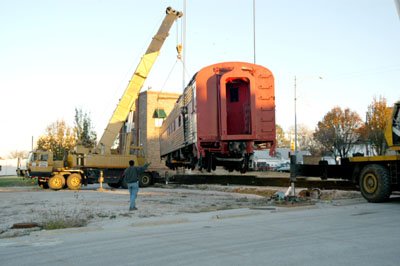|
«
Contents
|

A pair of giant cranes lifts the vintage Pullman Dining Car from the
grounds of a Missouri train yard before beginning its trip to the
A Philip Randolph Pullman Porter Museum in Chicago, Illinois
The historic link
between labor and the civil rights movement was renewed recently when
the Machinists Union and the A. Philip Randolph Pullman Porter Museum
joined forces to acquire a vintage rail car for a “Living History”
exhibit to honor the legendary Pullman Porters.
During the so-called golden age of rail travel, Pullman Porters worked
as valets and attendants in cars built and operated by railroad baron
George Pullman.
In 1937, the porters, under the leadership of A. Philip Randolph,
overcame tremendous obstacles to become the first black labor union to
win a collective bargaining agreement with a major U.S. corporation.
The search for a vintage Pullman car that could be restored and opened
to the public as an educational exhibit began last August during the
seventh annual “Honoring the Brotherhood” ceremony on the museum’s
grounds in Chicago.
International President Tom Buffenbarger and museum founder Lyn Hughes
discussed the proposal in great detail. Before the weekend was over, the
idea was a step closer to reality.
The IAM would join the search to find a Pullman car for the museum,
pledged President Buffenbarger. “We’ll issue a call for help among our
rail members and, if one exists and if it’s for sale, we’ll do what we
can to get it on the grounds of this worthy museum.”
A Part of Labor
History
The name Pullman is
a part of U.S. labor history as far back as the 1870’s. In the early
days of rail, company founder George Pullman built the world’s first
industrial community. Workers from the nearby Pullman train yards and
foundries could live in comfort and conditions very unlike the teeming
slums of nearby Chicago.
The utopian idea quickly crumbled following the depression of 1894 and
the experiment named Pullman became just one more company town where
workers fought back, turning to unions for the dignity and respect
previously denied them.
In the years that followed, the company’s passenger cars, sleepers and
dining cars continued to roll behind nearly every locomotive in the U.S.
The last Pullman rail car was built in 1958. The factory later closed
despite a bitter struggle by unionized workers to keep the facility
operating.
All Aboard the
Internet?
From his office in
Chicago, Ron Watkins, the director of business development for the
museum, began searching for a Pullman by scanning the Internet. It
wasn’t long before he was talking with the owner of a small train museum
in Springfield, MO.
Yes, they had a Pullman car – a dining car in fact. And yes, it was for
sale. It seems the rail museum in Springfield, like the Pullman company
itself, had fallen on hard times and was about to close its doors.
Following a thorough examination by train technicians dispatched by IAM
District 19 President Bob Reynolds, the car was found to be in
remarkably good condition. A price was agreed to and welders set to work
to free the car for the trip to Chicago.
When the restoration is complete and the dining car is joined by a
companion sleeping car, visitors to the Pullman Porter Living Museum
exhibit will experience sleeping and eating in Pullman cars.
Actors will reenact the role of Pullman Porters and relate the epic
story behind the storied company and the porters’ impeccable manners and
quiet strength. |